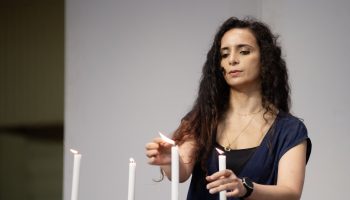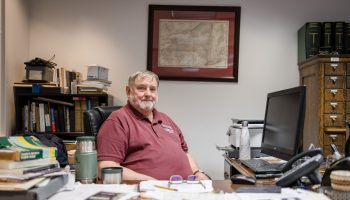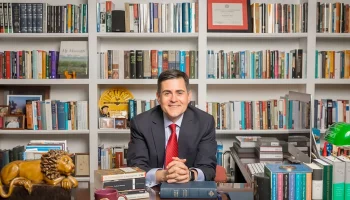
Gabriel Weber
Staff writer
Before kicking off his lecture, Pablo Hernandez Basulto first wanted to get to know the entire audience.
He posed questions to understand who had attended public theater before and who had been to Shakespeare in the Park — many Chautauquans raised their hands to indicate their participation in the long-established traditions.
Hernandez Basulto spoke at 10:45 a.m. Wednesday in the Amphitheater for Chautauqua’s Week Three theme of “Art in Action: Building Community Through the Arts.” Director of the Civic Artistic Programs and responsible for the Public Works and Mobile Unit initiatives at The Public Theater in New York City, Hernandez Basulto wrestles with big questions about what the future holds for artistic programs.
Prefacing his talk with a focus on belonging, what community means and where the role of art lives, Hernandez Basulto began with history vital to The Public Theater.
Growing up in Brooklyn, Joe Papp, creator of Shakespeare in the Park, had access to culture in a way that allowed him to read Shakespeare for free, “which embodied what it meant for him to own culture and for culture to belong to him,” Hernandez Basulto said. When Papp was serving during World War II, he started a theater group and came back to New York hungry for more theater.
Papp gathered some friends and started offering free Shakespeare to New Yorkers at parks all over the city. When he partnered with the sanitation department in the 1950s, the group secured a big truck, and eventually it broke down next to the Central Park Turtle Pond — where the group decided to stay.
Eventually, Parks Commissioner Robert Moses argued to end free admission to the performances, but the litigation battle that ensued ended with Papp’s right to offer Shakespeare in the Park for free, stating that the parks could not enforce a charged admission. Papp joined the American regional theater movement, pairing up Shakespeare in the Park with a theater Papp conceived downtown called the Delacorte Theater; the showing of Hair “launched the potential of what this could be,” Hernandez Basulto said.
Working on the Mobile Unit and Public Works initiatives are like two halves of a circle, he said. The Mobile Unit tours community partner sites all over the city — hitting all five boroughs of New York, while also going to correctional facilities and community centers.
“There’s all sorts of places where performance can happen and we’re acting as equals in that moment,” Hernandez Basulto said. “We’re creating space where professionals and an audience get to meet in a space that’s their own.”
Public Works seeks partnerships with community organizations, builds relationships with their members and invites them to audition; every year, 100 of them get to be in a giant piece of theater.
“They complete that sense of what it means to build a relationship with the city,” Hernandez Basulto said. “(Both initiatives) continue that legacy of what theater institutions can be like when they’re not focused on a commodity and instead focused on our relationships. That’s the whole point of a nonprofit in a way — we’re trying to build relationship with the community, which is 8 million people in New York.”
When their Mobile Unit toured Rikers Correctional Facility, there were many expectations of rowdiness and tension. Instead, Hernandez Basulto saw the audience leaning in with anticipation of the stories being told onstage.
“Rikers was the most attentive audience I have seen in my entire life. There are people hanging on to every single word,” Hernandez Basulto said. “I start thinking to myself, of course, this is exactly what theater is; correctional facilities try to dehumanize people in a systematic way. I’m grateful they allowed us to come in, because there are moments of humanity.”
Hernandez Basulto stressed the difference between theater as an artform and theater as an industry, which received a huge round of applause from his audience.
“Theater the artform — gathering, telling stories — can’t be owned. Culture belongs to everyone. There’s no controlling where stories get to come from,” Hernandez Basulto said. “Industry is the tiny little box that we put around the artform in order to make money from it and survive in the structures that we exist in.”
The Public Theater has an affiliate network of feeders around the country and internationally to build momentum for community-based theater. With the development of this kind of resource sharing, Hernandez Basulto reminded the audience that art is made to be shared.
“With theater the artform, we must resist the temptation to think about these things as ownership and discovery; they are successful because we think of them as principles,” Hernandez Basulto said. “We’re returning to the genesis of theater. This is what makes it be able to be owned — it’s a human thing.”
One of the facets of President Franklin D. Roosevelt’s Depression-era New Deal was employing artists, leading to the creation of programs that ended for a time with the McCarthy era. In carrying on the legacy of those New Deal arts programs and the ones that came after, Hernandez Basulto feels it’s important to brainstorm for the expansion of artistic spaces that offer belonging.
“We’re trying to think about how large institutions should acknowledge this responsibility of what it means to engage with cultural places,” Hernandez Basulto said. “There are so many hyper-local organizations that do what I’m talking about every single day — what does it mean for us to be the best leaders of this place?”
Bitten by the theater bug in kindergarten at 6 years old when his mom would organize performances of Disney sing-alongs, Hernandez Basulto said that was the moment when he felt like anything was possible.
“That’s catharsis, that is the effect of what good art is trying to do. Theater artists are trying to get you to empathize with this character and their circumstances,” Hernandez Basulto said. “What we do with Public Works is try to play around with the elements of what ‘professional’ is and make some room for the ‘nonprofessional,’ meaning this is not tied to how we make money out of these spaces.”
The values that underpin Hernandez Basulto’s work are access, civic engagement and artistic innovation.
“When we talk about what it means to be free at The Public, this legacy of removing these barriers is now an opportunity for people from all parts of the city, who can agree that there are ways we could work together across divides,” Hernandez Basulto said. “This public work should exist because a place called New York exists.”
Questioning the function of institutions that filter out a certain subsection of people, namely poor people, Vice President of Performing and Visual Arts Laura Savia urged the audience to consider who’s not in the room.
“If stories are the way that we understand information, then (for) those of us whose responsibility it is to tell stories, we have a responsibility to tell stories that demonstrate interconnectedness,” Hernandez Basulto responded. “What does (that filter) say about the function of this space?”
For those shared spaces, Hernandez Basulto believes arts institutions should be examining what it means to be a public good.
“My experience is that we often believe wholeheartedly there should be a place in every community that is a curator of what good art is and what bad art is,” Hernandez Basulto said.
Considering what comes next for artistic programs, Hernandez Basulto finds that they should be really thinking about the effect that they’re producing. While the “dream for The Public would be that every ticket is free all year round,” he said, we’re not quite there yet.
“The challenge is we are being a little too quiet about our function, and that doesn’t allow us to make informed choices. In a hypothetical theater, in order to exist, these folks need to come every year,” Hernandez Basulto said. “That must be a part of what we do — that’s how we make money. But I think we must remember that our power as an artform lies in who we gather and that should continue to be guiding us when we make these decisions.”




